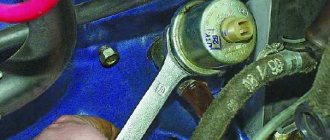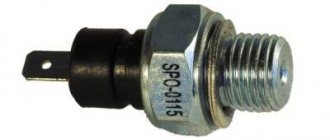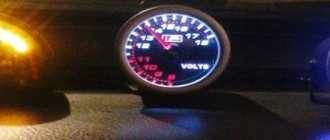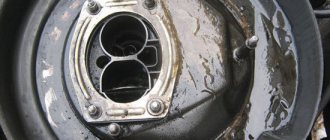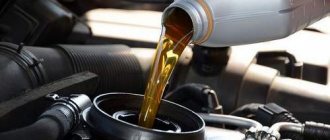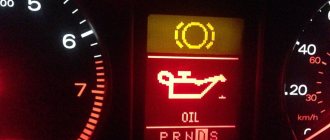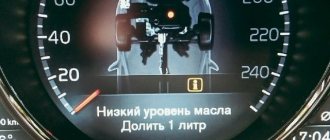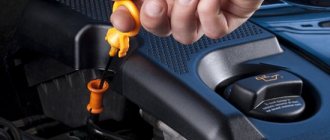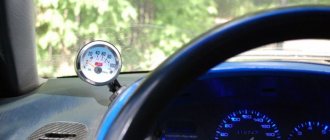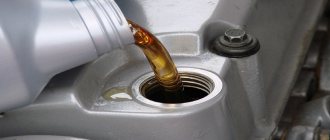There is a light on the instrument panel that indicates emergency oil pressure in the engine. When it lights up, it is a clear sign of a problem. We'll tell you what to do if the oil pressure light comes on and how to fix the problem.
The oil check light can come on for two different reasons: either low oil pressure or low oil level. But what exactly does the oil light on the dashboard mean, only the operating instructions will help you find out. It will help us that, as a rule, budget cars do not have a low oil level indicator, but only a low oil pressure indicator.
When might the warning light come on?
The oil pressure in the engine can drop for various reasons, some of them are insignificant and do not cause harm to the engine, while others, on the contrary, can cause serious damage to the power plant, which can only be eliminated by carrying out a major overhaul.
Therefore, the lighting of a special warning lamp is a serious reason to start looking for the cause.
The oil pressure light can come on in a variety of situations, starting with the fact that it simply does not go out after starting the engine and glowing while driving.
This problem can appear both “hot” and “cold”, at medium loads and at idle, as well as after a planned replacement of the lubricant (especially when switching to a new brand of oil).
When the pressure warning light comes on, this is not a situation where “I’ll just get home and see.” When such a signal appears, measures should be taken immediately.
The first thing to do is to immediately turn off the engine and stop driving. And then look for the cause on the spot or organize delivery of the car to the repair site (by tug, tow truck).
Note that sometimes failures in the sensor occur, so as one of the first measures you should wait 3-5 minutes and start the engine again and let it run in different modes.
If the sensor is “silent”, you can try to continue driving, but it is better not to leave the problem unattended and, if possible, check the components of the lubrication system. If the lamp comes on when the engine is restarted, the car will have to be towed.
Oil pressure sensor malfunction
The oil pressure at idle speed (at approximately 800 - 900 rpm) should not be less than 0.5 kgf/cm2. Sensors for measuring emergency oil pressure come with different response ranges: from 0.4 to 0.8 kgf/cm2. If a car is equipped with a sensor with a response value of 0.7 kgf/cm2, then even at 0.6 kgf/cm2 it will turn on a warning lamp, signaling a kind of emergency oil pressure in the engine.
To understand whether the oil pressure sensor is to blame for the light coming on or not, you need to increase the crankshaft speed to 1000 rpm at idle. If the light goes out, then the oil pressure in the engine is normal. If not, then you need to contact specialists who will measure the oil pressure with a pressure gauge, connecting it instead of the sensor.
Cleaning the sensor helps prevent false alarms. You need to unscrew it and thoroughly clean all the oil channels, because the cause of false alarms of the sensor may be due to blockages.
Main causes of malfunction
Structurally, the lubrication system is quite simple, but its functioning can be affected by other engine elements. Therefore, there are quite a few reasons why the warning light comes on:
- Oil pressure sensor malfunction;
- Damage to the sensor-indicator light circuit;
- Exhaustion of lubricant life or its inadequacy;
- Low oil level;
- Clogged oil filter element, malfunction of its bypass valve;
- Clogged oil intake;
- Oil pump wear;
- Reducing valve jammed;
- Critical wear of engine components (crankshaft and timing gear);
- Penetration of other technical liquids into the pan.
Note that these are only the main and general causes of a drop in oil pressure, which are typical for any engine. But there are also reasons that occur only on certain car models.
Indicator light is on - emergency situation
If the lubricant pressure light is on or flashing, this is a signal of a possible emergency. It is necessary to stop the car, turn off the engine and figure out why the oil pressure sensor lamp is blinking on a warm engine. This could be one of the options:
- Reduced level of oil solution. It is necessary to inspect the crankshaft seals, engine sump, and cylinder block. The indicator may light up because there may be a lubricant leak and its level may decrease. The second option, due to which the level can drop sharply, is a lubricant leak through the oil filter or pressure sensor. To prevent breakdowns, you need to add lubricant and slightly exceed its level. When the indicator goes out, you need to drive to the nearest service station.
- There is no pressure and the oil solution level is low. No leaks detected, but the level continues to decrease. It is recommended to add lubricant, start the power plant and warm it up to assess the color of the smoke from the exhaust pipe. Dark blue smoke means that the fuel system is faulty and the rings are flushing remaining fuel into the crankcase. White smoke means that liquid from the cooling system is entering the crankcase oil bath.
- The warning light does not light up after turning the key in the ignition switch. There are several possible faults:
- The lubricant pressure indicator has failed. To check, you need to turn on the ignition, disconnect the wires from the indicator and short them to the housing. If the light is on, the indicator must be replaced.
- No voltage is supplied to the indicator. The contacts may have oxidized and need to be cleaned.
- The light bulb has burned out and needs to be replaced.
- The indicator lights up after the power unit starts. It is likely that the lubricant is at high temperature. It is necessary to increase the crankshaft speed. If the warning light goes out, you can return the rotation to operating mode and continue driving.
- The lubricant pressure warning light comes on while driving or when increasing the fuel supply. The lubricant level has dropped low. You need to raise the lubricant level a little higher than normal and slowly drive to the nearest auto repair shop.
Emergency measures
So, the oil pressure light on the dashboard came on while driving. As already noted, you should immediately stop and turn off the engine. Since while on the road there is no way to accurately determine the cause of the problem, the only diagnostic method is a visual inspection.
After stopping the engine:
- Carefully inspect the power plant for oil leaks - valve cover, pan, oil filter, end surfaces of the engine (near the auxiliary drive pulley and on the gearbox side);
- Check the condition of the circuit to the oil sensor, while monitoring (as far as possible) the integrity of the wire;
- During the time it takes for a visual inspection, the oil will drain into the pan, so we check its level with a dipstick.
Depending on the results of the inspection and level check, we take further actions. If a slight leak is detected, and the dipstick shows the amount of lubricant below o, you can continue moving to the repair site, but first replenish the oil loss and check whether the warning lamp lights up.
To top up, you should use the same lubricant that was filled in (it is not for nothing that it is recommended to always carry oil with you for topping up) or purchase a similar one. During the movement, you should stop periodically and replenish the level.
READ ON THE TOPIC: What oils should be poured into the engine.
We do the same in the case when no leaks are detected, but the level is below normal. We just add lubricant, make sure that the control light does not light up and continue on our way, periodically stopping and checking the dipstick.
If there are no leaks and the oil level is normal, it is possible that the pressure sensor is acting up. Restarting the engine after a short pause (the time it will take to inspect the engine and assess the amount of lubricant) will help verify this.
If the lamp lights up even when you restart it, it is better not to experiment, but to call for help to transport the car to the repair site.
It is strictly forbidden to operate the machine if the dipstick shows a level higher than normal or if there is a foamy whitish coating on it - emulsion (you can additionally check for the presence of emulsion on the oil filler cap).
This indicates that other technical fluids, such as antifreeze or fuel, are leaking into the pan. An excessive level of oil (liquid mixture) in the pan has a strong negative effect, as does its lack.
The problem is diagnosed by the non-characteristic color of engine oil and smoke from the exhaust pipe.
These are all the measures that can be taken in an emergency situation - when the lamp lights up while driving and there is no necessary equipment and tools for a more detailed search for the cause.
Low engine oil pressure, causes
Signs of low oil pressure in a car engine are: a warning light in the form of an oil can on the instrument panel that lights up or flashes periodically, the STOP indicator lights up, and increased noise and vibration when the engine is idling.
There are several reasons for this malfunction, some of them can be easily fixed on your own, some require serious engine repairs. Using the example of engine 21083 of VAZ 21083, 21093, 21099, we will consider most of them. We will also determine what needs to be done immediately when a problem is detected in order to avoid major engine repairs, since oil starvation is contraindicated for its rubbing parts.
Causes of low oil pressure in a car engine
Low engine oil level in the engine sump.
After parking the car, you need to remove the dipstick and check the level. It should be midway between the minimum and maximum marks or closer to the maximum. Below the middle level is considered low and requires adding engine oil. Otherwise, the oil pressure in the engine lubrication system will be low.
Add oil through the oil filler neck, keeping in mind that there is about a liter between the minimum and maximum marks. In the future, you need to establish the reason for the decrease in oil level.
Engine oil level on dipstick
The engine oil is not suitable for this engine.
It's too runny. For example, when low-viscosity synthetic motor oil is used on an engine with a mileage of under 200 thousand km and large gaps in the rubbing parts. Or, when changing the engine oil, oil was added whose characteristics do not meet the factory requirements and tolerances for this particular engine. In any case, if there is a suspicion that low oil pressure in the engine is due to poor quality or inappropriate oil, it should be completely replaced.
Read more: “Choosing motor oil for VAZ 2108, 2109, 21099 engines.”
Gasoline gets into the engine oil.
Through a worn (not sealed) fuel pump diaphragm, gasoline enters the engine oil. This leads to dilution of the engine oil, loss of its lubricating properties and, as a result, a decrease in the service life of the rubbing parts of the car engine. In the most advanced cases, call for an immediate overhaul of the engine. As the viscosity of the oil decreases, its pressure in the lubrication system drops.
Gasoline in motor oil
It is necessary to check the presence of gasoline in the engine oil, eliminate the malfunction of the fuel pump, and replace the engine oil with new one.
Coolant gets into the engine oil.
A “broken”, poor quality, incorrectly installed, or warped engine head gasket as a result of overheating can cause coolant (antifreeze, antifreeze) to enter its lubrication system. An increase in the oil level in the pan, a whitish emulsion on the oil filler cap and (or) on the dipstick are signs of this malfunction. The result is low oil pressure in the engine and the emergency pressure lamp in the instrument panel flickers or lights up.
Emulsion on the dipstick and engine oil filler cap is a sign of the head gasket burning out and coolant getting into the engine oil
In such a situation, it is necessary to establish with sufficient accuracy that the gasket is not sealed and coolant gets into the oil. If there is a malfunction, a serious engine repair is required, which involves at least replacing the gasket, and at most grinding or replacing the cylinder head.
Details about the malfunction: “Coolant in the engine oil, why and what to do?”
The sensor for the emergency oil pressure lamp in the instrument panel is faulty.
If the warning lamp for emergency oil pressure in the instrument cluster comes on (as a result of low oil pressure in the engine), first of all, check the reliability of the contact between the wire tip and the output of the oil pressure sensor. If this does not help, with the ignition on, remove the wire tip from the sensor and touch it to the “ground” (engine, body); if the light goes out, the sensor is faulty and must be replaced. If it does not go out, there may be other malfunctions described in this article.
Oil pressure sensor MM120D VAZ 2108, 2109, 21099
The engine oil filter is faulty.
If the oil filter has not been changed for a long time (several oil changes) and becomes clogged, if low-quality oil was used, or there is a mechanical defect in the filter, it may reduce the efficiency of the engine oil passing through the lubrication system. Naturally, the oil pressure decreases and the warning light flashes or lights up.
We replace the oil filter with a new one that matches this particular engine.
Replacing engine oil filter 21083
The oil receiver in the car engine sump is clogged.
Oil from the engine sump is drawn into the lubrication system through a round oil receiver installed in it. Over time or as a result of using low-quality engine oil, the small holes in the oil receiver become clogged, preventing the oil from flowing normally into the lubrication system. Oil pressure drops. A sign of this malfunction is the emergency pressure lamp flashing at idle; the blinking stops and the lamp goes out when the engine speed increases.
Oil receiver in a car engine sump
To eliminate the problem, you will have to remove the engine sump, remove the oil receiver, clean it, rinse it with gasoline, and blow it with compressed air. It is recommended to carry out this procedure once every hundred thousand mileage.
The oil pump is faulty.
The service life of the oil pump is quite long. It can cover 200 thousand kilometers or more. Over time, its rubbing parts wear out - the driven and drive gears, the seat for them in the pump housing, and the pressure-reducing valve that sets the pressure in the engine lubrication system may become stuck. In addition, dirt can get under the pressure reducing valve and jam it. All these malfunctions lead to a decrease in oil pressure.
If the car has a good mileage or it is unknown what kind of oil was poured into the engine, it makes sense to remove the oil pump, check it and (or) replace it.
Checking the oil pump - measuring the gap between the gears and the ruler
The journals or bearings of the crankshaft and camshaft are worn out.
On engines with high mileage, there is wear on the journals and (or) bearings of the crankshaft and (or) camshafts of the engine. Since the gap in the rubbing journal-liner pair increases, such an engine will not hold pressure.
The engine crankshaft bearings have turned.
As a result of poor-quality engine repairs, the use of low-quality and inappropriate motor oils, harsh operating conditions, and oil starvation, the crankshaft liners can be torn off their seats and rotated. In such a situation, the engine oil pressure will drop immediately, the warning light will come on, the engine will lose power and throttle response, and will stall.
In the case of wear of the liners or their turning, it will be necessary to carry out a major overhaul of the engine by replacing the liners and checking the crankshaft journals for wear, scuffing and overheating.
Notes and additions
— In the engine lubrication system of VAZ 2101, 2103, 2106 cars, an engine oil pressure sensor and a dial indicator connected to it were installed. Which was convenient when independently diagnosing engine malfunctions, since oil pressure is one of the main indicators of engine serviceability or malfunction. In some cases, it is possible to install a pressure sensor and indicator on a VAZ 2108, 2109, 21099 car and their modifications.
— Normal pressure in the lubrication system of a car engine is considered to be a pressure within 2 kgf/cm² at idle and 4.5 - 6.5 kgf/cm² at high speeds.
More information on the topic in our VKontakte group -
Twokarburators VK , on Facebook Twokarburators FB , as well as in Odnoklassniki - Twokarburators OK
More articles on engine malfunctions of VAZ 21083, 21093, 21099
— What is compression in an engine?
— Oil starvation in the engine, causes and consequences
— Signs of wear on valve stem seals
— Checking the pressure in the car engine lubrication system
— Oil in the engine air filter housing, why?
— Signs of wear or stuck engine piston rings
— Why did the engine 21083 of VAZ 21083, 21093, 21099 sag?
Consequences of ignoring the problem
Stopping the engine when the pressure lamp lights up is a mandatory measure. Ignoring the signal can result in very serious problems:
- As a result of “oil starvation”, the contacting surfaces of components and mechanisms will begin to work “dry”, which will lead to their intense wear and high heating. If you take a crankshaft, the main and connecting rod bearings will begin to melt and “wrap” around the journals, which will lead to jamming of the crankshaft;
- Lack of lubrication will lead to intense wear of the camshaft “bed”;
- Wear products - small metal shavings - will spread through the channels of the lubrication system, which can lead to their clogging. Also, chips can cause jamming of the pressure relief valve and damage to the oil pump gears.
Elimination of such malfunctions is only possible through a major overhaul of the power plant.
If the oil level is normal and the sensor is working
First of all, you need to check the oil dipstick and make sure that the oil level has not increased since the last check? Does the dipstick smell like gasoline? It is possible that gasoline or antifreeze is getting into the engine. It’s easy to check the presence of gasoline in the oil; you need to dip the dipstick in water and see if gasoline stains remain. If yes, then you need to contact a car service; the engine may need to be repaired.
If there is a malfunction in the engine, which is caused by the oil pressure light coming on, it is easy to notice. Engine malfunctions are accompanied by loss of power, increased fuel consumption, and black or blue smoke coming out of the exhaust pipe.
If the oil level is normal, then there is no need to worry about a prolonged indication of low oil pressure, for example during a cold start. In winter, at low temperatures, this is an absolutely normal effect.
After parking overnight, the oil drains from all lines and thickens. The pump needs a certain time to fill the lines and create the necessary pressure. Oil reaches the main and connecting rod journals earlier than the pressure sensor, so wear of engine parts is eliminated. If the oil pressure light does not go out for about 3 seconds, it is not dangerous.
Looking for a fault
Until the cause of the oil pressure light coming on is eliminated, it is better not to operate the car. To solve the problem, you can contact a service center, or identify and fix the problem yourself, saving on service station services. Much depends on the make of the car.
If there are no visible causes of the problem - there are no leaks, and the level is normal, we carry out diagnostics.
Self-testing is carried out “from simple to complex.” The main working element of the system is the lubricant. Therefore, we check it first.
If the lubricant is not changed on time (every 8-10 thousand km), perhaps the oil has exhausted its resource and has become very liquid, which is why the oil pump is not able to pump it in the required quantity, creating the necessary pressure.
In cases where the lubricant has been changed relatively recently, make sure that the tolerance and specification of the engine oil that was filled in matches the car’s engine.
Next, we move on to the next stage of testing - measuring the pressure in the system.
Where to start looking for reasons
What to do if the indicator light comes on?
The engine must be stopped. Operation cannot be continued until the cause of the malfunction in the lubrication system is determined.
Checking grease loss
You need to look under the car. The presence of smudges will indicate loss of lubricant. Typically, oil stains appear long before problems arise with the sensor.
If it is dry under the car, then the reasons may be hidden inside. You need to remove the dipstick, wipe it thoroughly with a rag, and then measure the oil level in the crankcase.
If you notice a deficiency, you should purchase a new one from the nearest spare parts store and top it up to the required level. It is not advisable to mix different types of oils with each other.
Attention! What is needed is the one that was filled during the last maintenance. At stations, they usually indicate the brand of consumables used in the service card.
Oil level has not decreased
It’s worse if the level has not decreased and there is no pressure. Only a specialist can check the presence of real pressure.
It is advisable to do the work together. One will be in the cabin. Its job is to start and stop the engine. The second watches the motor itself.
- To do this, unscrew the pressure sensor.
- A plug is installed in its place. It can be made by crumpling up a sheet of paper. The hole is tightly plugged with a paper stopper.
- The engine starts for 1-2 seconds.
- If the plug has come out, then there is pressure in the system. You need to screw the sensor back into place and go to the nearest store to buy a new one.
- If the plug remains in place, then further movement is not allowed. You need to call a tow truck. You will have to look for a breakdown at a service station.
What pressure should be in the system?
The sensor serves only to determine the pressure drop, but it does not indicate the exact indicator of this parameter. Therefore, a conventional 10 bar dial pressure gauge is used for measurement.
For measurements, you can use any device, adapting it to the engine or using a pressure gauge specially designed for this.
To use a conventional pressure gauge, you will have to improve it a little so that it can be connected to the motor. To do this, you will need the pressure gauge itself, a piece of thick-walled rubber tube, clamps and a threaded fitting for the hole for installing the pressure sensor.
We connect all this into one structure, and securely clamp the joints of the tube with the pressure gauge and fitting with clamps.
With a special pressure gauge for measuring oil pressure on engines, such a procedure is not required, since it is already equipped with a fitting and adapters for connecting to the engine.
Measurement is performed using the following technology:
- Disconnect the wire and unscrew the pressure sensor;
- We screw the pressure gauge into the sensor seat and tighten it well (but do not overdo it, since the thread in the hole is aluminum and breaks easily);
- We briefly start the engine (a short period of engine operation will not cause any damage);
- We look at the device readings.
If the pressure gauge shows pressure above 1 Bar, the lubrication system is functioning normally and the cause should be sought in the sensor or wiring.
Checking the lubrication system components
If replacing the sensor and ringing the wiring did not bring any results, and the lamp still works, you should look for the cause further.
The next steps are:
- REPLACE THE OIL FILTER. This element is equipped with a bypass valve and if this valve does not work, then after starting the engine the system needs time to pump oil (this problem manifests itself in the form of a constantly burning light after starting). Another problem associated with the filter is its severe clogging, which is why it creates a strong obstacle to the movement of oil, preventing it from rising to the cylinder head where the sensor is installed;
- REMOVE THE PAN AND INSPECTION THE OIL PICKUP. Over time, the intake mesh becomes clogged with various deposits (this is especially true with frequent changes of oil brands and the use of additives). Due to deposits, it is difficult for the pump to “pull” the required amount of working fluid from the pan, so the pressure will be insufficient;
- CHECKING THE OIL PUMP. Backlash and wear marks on the gears will indicate severe wear. Due to the gaps, the unit is simply not able to pump oil and a loss of pressure occurs;
- WE ASSESS THE CONDITION OF THE REDUCTION VALVE. This element is designed to relieve pressure when a certain value is exceeded. But if the valve gets stuck in the open position, it will leak oil, preventing the pump from pumping up the required pressure.
These indicate the causes of pressure drop associated with the lubrication system.
Causes of a sharp drop in oil pressure
Usually this figure decreases gradually. A sharp decrease in oil pressure usually has the following reasons.
The pan is broken.
This often happens when driving over rough terrain or on roads with potholes and potholes. If the pan is punctured, the oil quickly flows out and the lubrication system stops working, which is immediately reported by the emergency indicator.
The pump has failed.
This phenomenon occurs infrequently, but drivers report that it does occur. Modern cars will immediately report a problem using indicators, but on older models you have to listen to how the engine is working.
Loss of oil through loose connections.
If the engine is poorly assembled or low-quality spare parts are installed in it, there are gaps between the individual elements. It is through them that the engine oil flows out. The pressure drops significantly, although not as rapidly as when the pan is punctured. The leak is easy to notice after the car has been parked: oil stains are visible in the place where it has been parked for some time.
Components affecting the operation of the lubrication system
But as already noted, other components and mechanisms can affect the functioning of this system.
Such mechanisms primarily include the KShM. If the engine has worked a significant life without major repairs, then wear of the elements of this mechanism will negatively affect the operation of the lubrication system as a whole.
Due to the large gaps between the crankshaft bearings and journals, there is a strong loss of oil pressure, which is why the lamp comes on. In this case, the problem can only be solved by a major overhaul.
The lubricant itself can aggravate the problem of component wear. The exhaustion of the resource or the mismatch of the oil brand can cause it to become very liquid after heating, which is why the pump cannot create pressure. You should pay attention to the condition of the oil if the lamp constantly comes on after the engine warms up.
Filling with thicker oil allows you to delay the overhaul or eliminate the “hot” signal, but this measure is temporary - eventually the engine will have to be repaired.
The oil pressure light came on: emergency
So, if the oil pressure light is on or blinking, this means that the pressure in the lubrication system has dropped, the engine must be turned off as soon as possible.
- Even if obvious leaks are not visually visible (for example, the valve cover is dry, there are no traces of oil on the cylinder block), and the oil level is low, then you should carefully inspect the installation location of the oil filter and oil pressure sensor.
Also, special attention should be paid to the front and rear crankshaft oil seals and the junction of the engine sump. Many cars will require a detailed inspection from below, which is difficult to do without a pit or lift.
For this reason, when inspecting the engine compartment from above, pay attention to the lower part of the gearbox. A leaking crankshaft rear oil seal causes lubricant to leak into this area.
- If a leak is detected, you need to add suitable oil (in case of severe leakage, overflowing slightly above the level is allowed). The engine can then be started. If the light goes out, then you can drive to the service station under your own power without loading the engine.
We also recommend reading the article about whether motor oils can be mixed. From this article you will learn whether lubricants of different brands (with different viscosities, base stocks and additive packages) are compatible with each other, as well as what oil can be added in case of a malfunction.
- If the lubricant level is low and there is no pressure, and no leaks are detected, then the lubricant needs to be added. After this, the engine is started to evaluate the color of the exhaust. Blue or bluish oily smoke from the exhaust pipe will indicate that the piston rings may be stuck, the rings are worn out, or there are problems with the cylinder bore (scuffing).
In other words, lubricant consumption is greatly increased (the engine eats oil). Increased pressure in the crankcase and problems with valve stem seals also lead to increased consumption. If after topping up the light does not light up or blink, then you can drive to the service station on your own, after which in-depth diagnostics are carried out.
Please note that if adding oil to the level does not solve the problem (the light on the panel is still on), then you cannot drive the car under your own power. It is also not recommended to tow the vehicle using a cable. It is best to call a tow truck to deliver the car for repairs.
Third-party liquids in the pan
As for the increased oil level, it is not necessary to check the lubrication system, since the reason for the lamp to operate is the ingress of technical fluids into the pan. And here it is necessary to establish where they are leaking from and eliminate the damage.
If instead of oil an emulsion of asphalt or another color is found, this is an antifreeze leak. Coolant usually ends up in the sump due to a damaged head gasket, which will have to be replaced to fix the problem.
But if there is no emulsion, but the level is higher than normal, and the oil itself is very liquid, fuel penetrates into the pan. The main reasons for this phenomenon are:
- Occurrence of rings;
- Misfires;
- CPG wear.
As a result of such malfunctions, the fuel supplied to the combustion chambers does not burn, but flows down the cylinder walls into the sump.
Another factor is winter.
The season of operation of the car can also affect the lubrication system. In winter, in severe frosts, the oil can harden so much that the first time after starting the engine the pump is not able to pump it in the required quantity. Preheating the pan before starting the engine can eliminate this problem.
Another reason for the pressure lamp to light up after starting the engine in winter is condensation. Due to temperature changes, moisture accumulates inside the engine, which then settles and freezes on internal surfaces, including the oil intake screen and oil channels. In this case, letting the car sit in a heated place will help - after the engine heats up, the condensate will melt and drain into the pan.
Note that the above describes the general causes of a drop in engine oil pressure, which are typical for any car - VAZ-2109, 2101, Priora, Niva, 2110, 2114, etc.
Let's sum it up
Taking into account the above, it becomes clear that the pressure in the lubrication system can drop for many reasons:
- oil quality or loss of its properties;
- leaks of oil seals, gaskets, seals;
- oil “presses” out of the engine (pressure increases due to malfunctions of the crankcase ventilation system);
- oil pump malfunctions, other breakdowns;
- the power unit may be badly worn, etc.
Note that in some cases, drivers resort to using an additive to increase oil pressure in the engine. For example, XADO revitalizant. According to manufacturers, such an anti-smoke additive with revitalizant reduces oil consumption, allows the lubricant to maintain the required viscosity when heated to high temperatures, restores damaged crankshaft journals and liners, etc.
It's rare, but it does happen that electrical problems arise. For this reason, the possibility of damage to electrical components, contacts, pressure sensor or the wiring itself should not be ruled out.
Finally, we would like to add that using only the recommended oil helps to avoid many problems with the oil system and engine. It is also necessary to select a lubricant taking into account individual operating conditions. The correct selection of viscosity index for the season (summer or winter oil) deserves no less attention.
Engine oil and filters must be changed correctly and done strictly according to regulations, since an increase in the service interval leads to severe contamination of the lubrication system. In this case, decomposition products and other deposits actively settle on the surfaces of parts and channel walls, clogging filters and the oil receiver mesh. Under such conditions, the oil pump may not provide the required pressure, causing oil starvation and significantly increasing engine wear.
